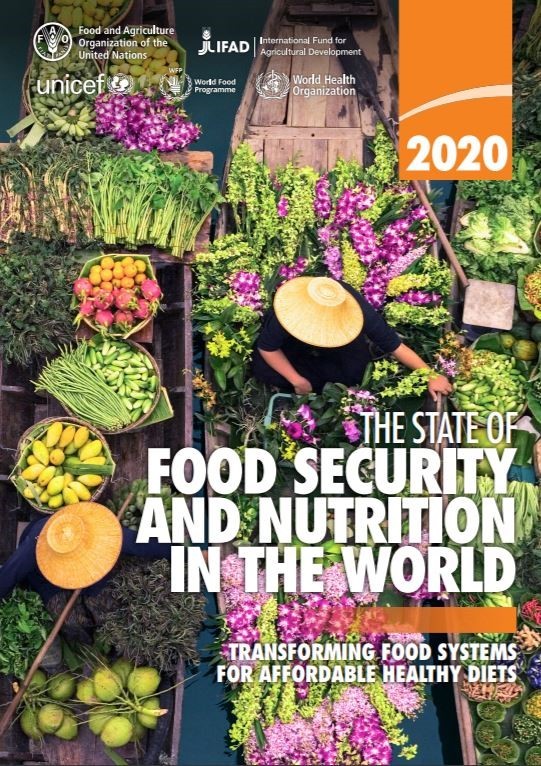Mentorship to empower African women in agribusiness
17 October 2024, Rome – The Food and Agriculture Organization of the United Nations (FAO) and…
The recent SOFI report brings troubling news, that nearly 690 million people are hungry– this is up by 10 million people in one year and that close to 750 million, or nearly one in ten people in the world, were exposed to severe levels of food insecurity and, potentially, that an estimated 2 billion people in the world did not have regular access to safe, nutritious and sufficient food.
 A key part of the report focuses on the cost and affordability of healthy diets showing that healthy diets cost 60% more than diets that only meet the requirements for essential nutrients. To address this, there will need to be significant changes in food systems at all levels, which will certainly be a focus of the forthcoming Food Systems Summit next year. This is going to need further work and analysis as, given the large diversity of current food systems and wide discrepancies in food security and nutrition status across and within countries, there is no one-size-fits-all solution for countries to shift towards healthy diets. For example, many lower-income countries, where populations already suffer nutrient deficiencies, may need to increase their carbon footprint to first meet recommended dietary needs and nutrition targets, including those on undernutrition.
A key part of the report focuses on the cost and affordability of healthy diets showing that healthy diets cost 60% more than diets that only meet the requirements for essential nutrients. To address this, there will need to be significant changes in food systems at all levels, which will certainly be a focus of the forthcoming Food Systems Summit next year. This is going to need further work and analysis as, given the large diversity of current food systems and wide discrepancies in food security and nutrition status across and within countries, there is no one-size-fits-all solution for countries to shift towards healthy diets. For example, many lower-income countries, where populations already suffer nutrient deficiencies, may need to increase their carbon footprint to first meet recommended dietary needs and nutrition targets, including those on undernutrition.
The report highlights several key issues, issues that farmers, small entrepreneurs, and those working in the value chain are familiar with. For many farmers, of all sizes, traditional staple foods generally carry a lower risk compared to the production of higher value and more nutritious foods. This can lead to insufficient diversification towards the production of horticultural products, legumes, small-scale fisheries, aquaculture, livestock, and other nutritious food products. This also limits the supply of diverse and nutritious foods in markets, resulting in higher food prices.
But while it’s accepted that diversified and well-integrated production systems can increase the availability of nutritious foods, the absence of access to knowledge, information and credit are risks that influence food producers’ decisions on whether to invest in crop production, livestock or aquaculture. So, this emphasises the ‘availability’ aspect of the analysis, which eventually impacts on “cost”.
 The SOFI Report notes areas that private sector are also already concerned about, highlighting that inadequate storage conditions and decisions made at earlier stages of the supply chain lead to products with a shorter shelf life. Adequate cold storage, in particular, can be crucial to prevent quantitative and qualitative food losses of perishable commodities. Furthermore, during transportation, good physical infrastructure and efficient trade logistics are of key importance to prevent food losses.
The SOFI Report notes areas that private sector are also already concerned about, highlighting that inadequate storage conditions and decisions made at earlier stages of the supply chain lead to products with a shorter shelf life. Adequate cold storage, in particular, can be crucial to prevent quantitative and qualitative food losses of perishable commodities. Furthermore, during transportation, good physical infrastructure and efficient trade logistics are of key importance to prevent food losses.
The Report rightly recognises that reducing pre-harvest and post-harvest losses in quantity and quality at the production level in the agriculture, fisheries and forestry sectors is an important starting point to reduce the cost of nutritious foods along the food supply chain. Fruits and vegetables and many animal source foods are highly perishable, especially fish, fresh milk, meat, and eggs. Lack of adequate market infrastructure and limited processing technology result in food losses and higher food prices. Improved technology and infrastructure in handling, storage, and processing (cool storage systems, cold chains, drying techniques, improved packaging) offers opportunities to reduce losses and lower consumer food prices.
These issues aren’t new and have been previously identified as , as the Report notes, the fact that the overall quality and efficiency of the national road and transportation network is critical in getting produce from the farm gate to markets at reasonable cost.
 The concern is that while the Report correctly recognises the need for a reorientation of agricultural priorities towards more nutrition-sensitive food and agricultural, the recommendations that include that public expenditures need to be stepped up to raise productivity, encourage diversification in food production and ensure that nutritious foods are made abundantly available, are still too general. It is well recognised, as the private sector continue to emphasis, that policies should promote investment in irrigation infrastructure specifically targeting strengthened capacity for all-season vegetable production, and other high-value commodities that can increase availability of nutritious foods. Key policy actions include investments in improved storage, processing, and preservation to retain the nutritional value of food products, rather than investing in highly processed foods and investment in all-weather rural roads. The challenge will be, as ever, implementing these recommendations.
The concern is that while the Report correctly recognises the need for a reorientation of agricultural priorities towards more nutrition-sensitive food and agricultural, the recommendations that include that public expenditures need to be stepped up to raise productivity, encourage diversification in food production and ensure that nutritious foods are made abundantly available, are still too general. It is well recognised, as the private sector continue to emphasis, that policies should promote investment in irrigation infrastructure specifically targeting strengthened capacity for all-season vegetable production, and other high-value commodities that can increase availability of nutritious foods. Key policy actions include investments in improved storage, processing, and preservation to retain the nutritional value of food products, rather than investing in highly processed foods and investment in all-weather rural roads. The challenge will be, as ever, implementing these recommendations.